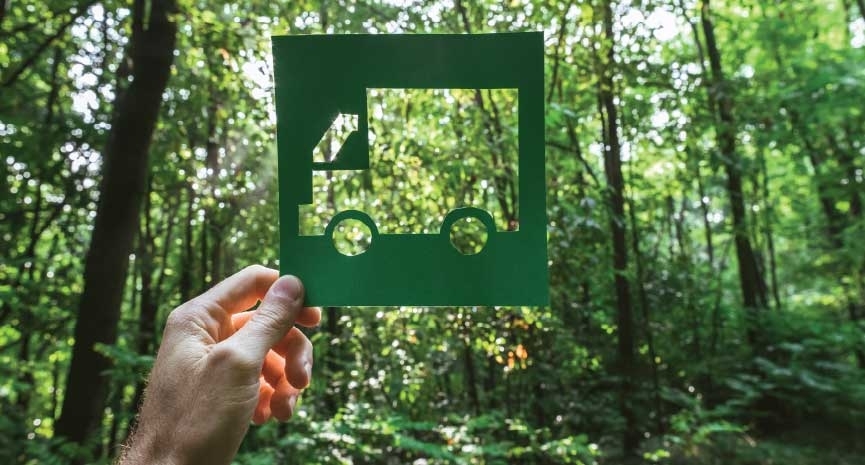FROM MAGAZINE: Top global megatrends driving sustainable logistics
The logistics industry world over is going through rapid transformation that we have seen never before. Crystal Lassiter writes on top five global megatrends driving sustainable logistics.

Negative emissions, or carbon drawdown (CDR) is a key element in fighting climate change, and this new partnership expansion between two global leaders is expected to make waves in the industry by helping to reduce the impact of human climate change
The logistics industry world over is going through rapid transformation that we have seen never before. Crystal Lassiter writes on top five global megatrends driving sustainable logistics.
From delivering packages between cities to transporting freight across borders, UPS moves 3 percent of global gross domestic product (GDP) through our network every day. As the world's largest package delivery company, making more than 20 million daily connections across 220 countries and territories, we are a critical player in facilitating global trade and supporting the world economy.
This perspective gives us a front-row seat to our customers’ challenges. We are an important part of their supply chain, so they look to us to bring solutions that reduce emissions across the value chain.
The world is changing fast, and we must anticipate and prepare for the next global megatrend to ensure our global logistics network is ready for the future.
With that reality in mind, here are five megatrends shaping the future of sustainable logistics.
1 Global talent shortage
Companies focus on building a workforce fit for the future. However, we expect a global talent shortage of 85 million people by 2030.
Among the most difficult roles to fill? Engineers, technicians and drivers — creating challenges for logistics companies.
UPS is one of the world’s largest private employers, so we are continually searching for new talent, especially during the holiday shopping season.
Through in-person hiring events such as “Brown Friday” and digital recruiting tools, we are reaching a wider talent pool. A reinvigorated focus on creating an experience where every employee can thrive helps us attract and retain the best candidates.
2 Climate change
By some estimates, the transportation sector contributes 18 percent of global greenhouse gas emissions — and growing. Emissions and pollutants from fossil fuel combustion and other sources are accelerating the impacts of climate change and poor air quality in cities, with 90 percent of people worldwide breathing polluted air.
As a global logistics company, we have a responsibility to manage our environmental footprint and help reduce emissions across our customers’ supply chains.
Through route optimization, fleet innovations and network efficiencies, we aim to reduce emissions 12 percent by 2025 across our ground operations, advancing toward a low-carbon future.
3 Urbanization
Cities are becoming more crowded every day, increasing congestion and smog and fundamentally changing how people and goods move around. More than 3 million people are moving into cities each week, and two-thirds of the global population will live in urban areas by 2050.
UPS is preparing for this rapid growth by investing in electric vehicles and eBikes that reduce emissions and congestion. They can also more easily manoeuvre through dense city centres.
We are also partnering to create more sustainable logistics solutions — today we are working on more than 30 pilot projects with cities around the world.
4 Emerging markets
Roughly 95 percent of the world’s population lives outside the US, many in emerging markets, creating opportunities to connect the world in new ways. By 2030, 62 percent of total growth in global consumption will come from emerging markets.
UPS is expanding our reach in these areas, and developing tools and partnerships to connect with small business owners — particularly women — through capacity-building programs that empower them to participate fully in the global economy.
5 E-commerce
With 10 percent of US retail sales conducted online and $5 billion spent globally on digital commerce platforms, e-commerce shows no signs of slowing down. Consumers have grown accustomed to more immediate deliveries, which creates environmental problems they might not always think about.
More e-commerce volume means more delivery trucks, more miles, more fuel and more emissions. UPS is applying advanced data analytics and automation to better manage package volume across our network.
We continue to devise new delivery solutions such as UPS My Choice, UPS Access Point locations, lockers and latch smart access devices, which allow drivers to deliver packages to an apartment building lobby or mail room.
These final-mile solutions enhance customer convenience while also enabling UPS drivers to complete deliveries on the first attempt — avoiding missed deliveries and associated emissions.
By embracing the megatrends shaping our future, we are not only improving operational efficiency but also creating more sustainable practices that will strengthen our business in a changing world.
Crystal Lassiter is a senior director of global sustainability and environmental affairs at UPS. Her responsibilities include developing and driving the strategies, initiatives and reporting activities that advance UPS’s sustainability goals.
This story was originally published in Logistics Update Africa's September - October 2019 issue.


